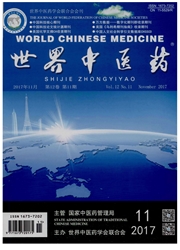

 中文摘要:
中文摘要:
目的:运用数据挖掘技术,分析现代针灸文献治疗鼻渊的"同功穴"选用规律。方法:采用计算机检索的方式,对1959—2015年中国知网、万方数据知识服务平台和维普数据库中针灸治疗鼻渊的相关文献进行检索及梳理,得到相关文献38篇,分析现代针灸治疗鼻渊"同功穴"的选用规律。结果:通过分析发现,现代文献针灸治疗鼻渊"同功穴"主要为迎香、印堂、合谷和风池;"同功穴"所属经脉主要为手阳明大肠经,其次督脉、足阳明胃经、足少阳胆经、足太阳膀胱经和手太阴肺经;"同功穴"所在部位主要是头颈部、下肢部和上肢部;"同功穴"的特定穴类别选用主要是五腧穴、原穴和络穴。结论:针灸治疗鼻渊,选取主治功效相同或相近的"同功穴",使腧穴配伍产生协同增效作用,可起到增强针灸治疗鼻渊的临床疗效。
 英文摘要:
英文摘要:
Objective: To analyze the rule of"Analogiczl acupoints"selection in modern literature of acupuncture treatment of Nasosinusitis based on data mining. Methods: Through retrieved CNKI,Wanfang,and Weipu Database on acupuncture treatment of Nasosinusitis from 1959 to 2015,38 related papers were got,which were analyzed for the selection rule of"Analogiczl acupoints".Results: According to the analysis,Yingxiang( LI20),Yintang( EX-HN3),Hegu( LI4),and Fengchi( GB20) were the most chosen"Analogiczl acupoints",which were belonged to Large Intestine Meridian of hand-Yangming,Du Meridian,Stomach Meridian of foot-Yangming,Gallbladder meridian of foot-Shaoyang,Bladder meridian of foot-Taiyang,and Lung Meridian of hand-Taiyin; Sites of the selected acupoints were mainly at the head and neck,lower limb and upper limb. Specific points were chosen from the category of five shu points,source points,and collateral points. Conclusion: Acupuncture treatment in Nasosinusitis at "Analogiczl acupoints"produces synergistic effect,and enhances the clinical curative effect.
 同期刊论文项目
同期刊论文项目
 同项目期刊论文
同项目期刊论文
 期刊信息
期刊信息
